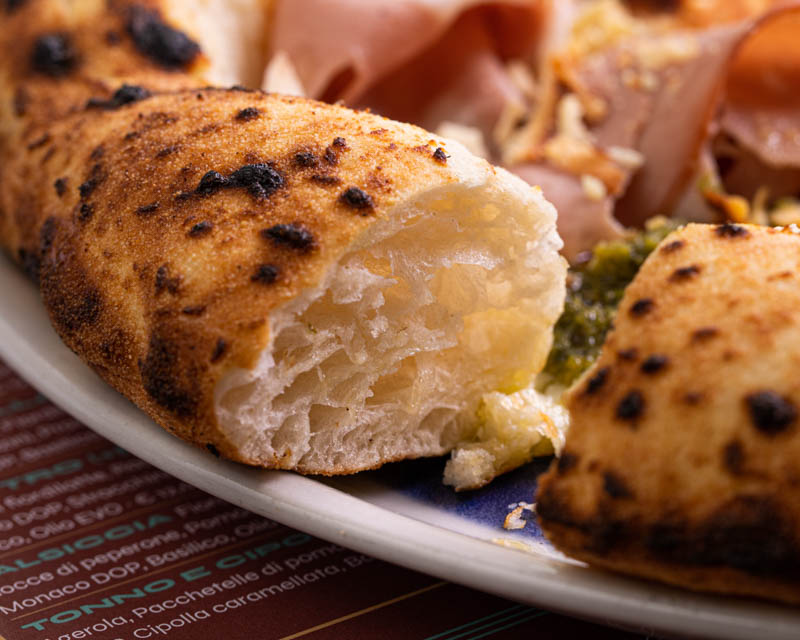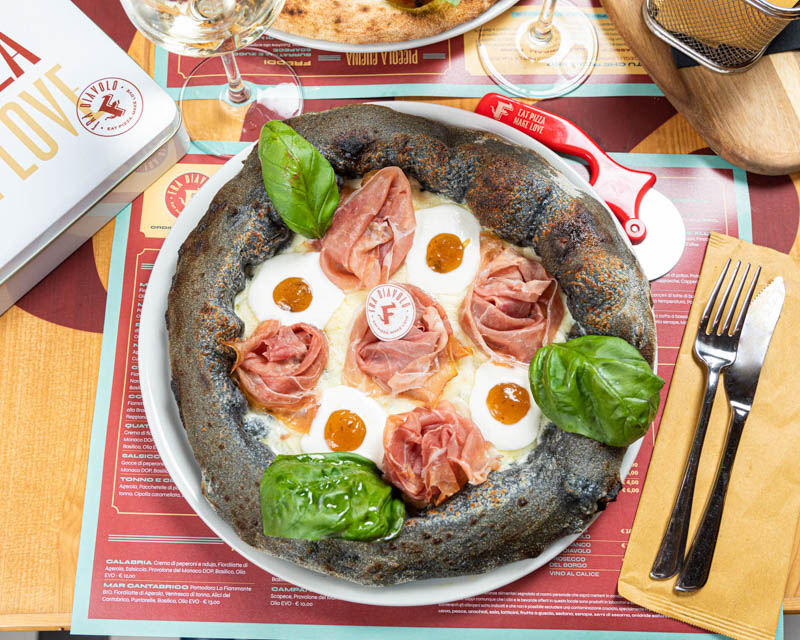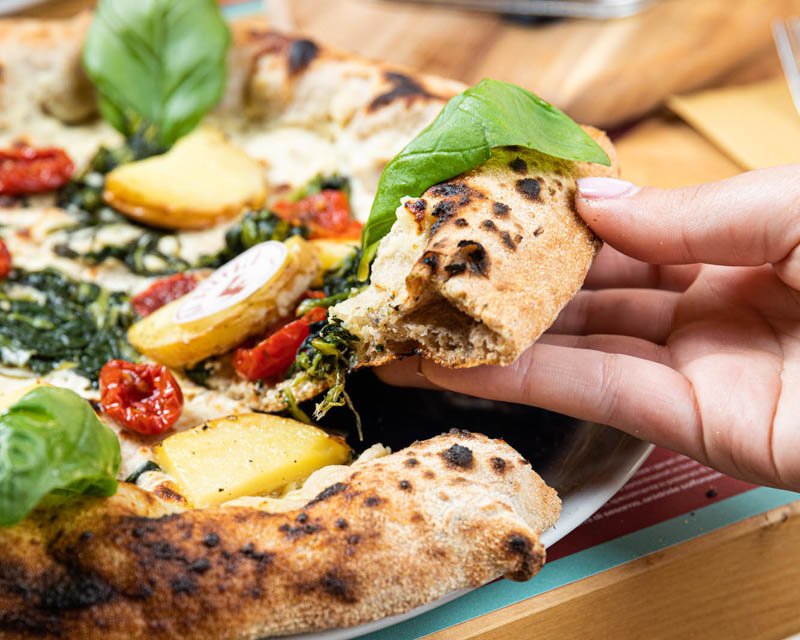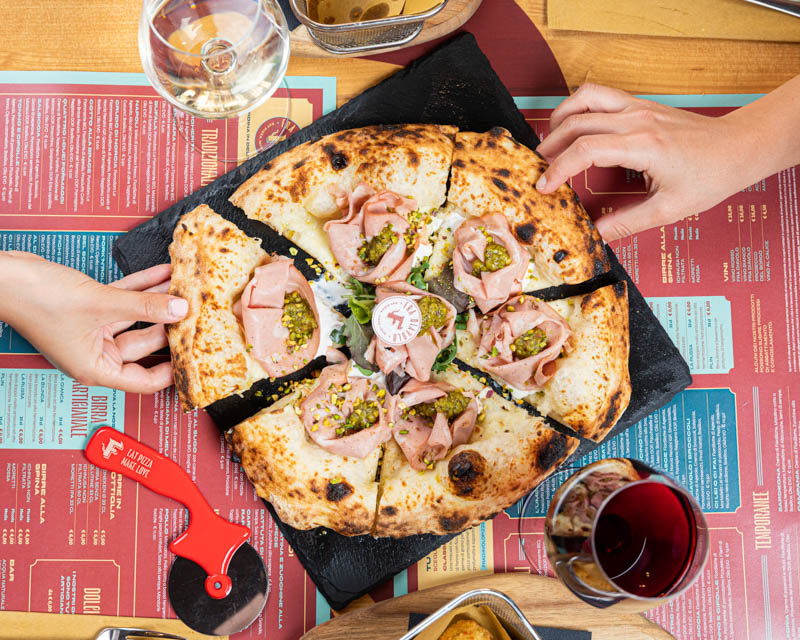CONTEMPORARY PIZZA: WHAT IT IS, WHEN IT WAS BORN AND WHERE TO EAT IT
Nowadays, running a pizzeria is very different from what it was twenty years ago: entrepreneurs in the sector are choosing to launch new restaurant formats, increasingly seeking to keep a precise product identity and to reflect the special characteristics of the area and its people. This is how Fra Diavolo's contemporary pizza was born: from the creativity of its pizza makers and the tradition of the Neapolitan people, put at the service of carefully selected craft raw materials. But what are its origins and what rules, ingredients and characteristics must a contemporary Neapolitan pizza have to be considered as such?

What does contemporary pizza mean?
The starting point for understanding the values that inspire a modern pizza is the desire to use a quality product while maintaining its organoleptic characteristics. Everything with the ambition of faithfully reproducing its flavour on a pizza and trying to offer the right tribute to the immense agricultural and food heritage of our country.
A true contemporary pizza is characterised by its light, long-rising dough, high, dimpled crust, the use of organic tomatoes and stone-ground flour and the choice of artisan ingredients.
The topping? Strictly selected and gourmet! Constantly changing combinations and seasonal ingredients create a constantly updated menu, where freedom of choice and quality are synonymous with luxury, goodness and pleasure that are accessible to every palate. You will find all this in the Fra Diavolo contemporary pizzeria!
When did traditional pizza evolve?
The origins of contemporary pizza can be traced back to Northern Italy, commonly regarded as the cradle of a revolution that has touched an enduring element of our culture: the Italian pizza and its entire production process.
Simone Padoan can be held as the inventor of contemporary pizza: he, in the 2000s, transformed pizza in a modern key, pursuing a philosophy centred on a meticulous search for excellent raw materials and innovative production techniques.
The use of sourdough, greater attention to the aesthetics of pizzas, dimpled dough, higher crust and seasonal toppings to be updated with each change of menu, just like in a restaurant: this is where the evolution of pizza started, following a slow and inexorable process that was rooted in tradition, only to then move away from it with great leaps. In its ecumenical value, traditional pizza has survived the test of time by remaining true to itself, but it continues to adapt to the new demands of a consumer increasingly seeking new taste experiences and gourmet toppings.
Contemporary pizza is never the same, it changes in appearance, composition and texture. The focus is no longer on the creator but on the product.Simone Padoan in his book "La Pizza contemporanea"
The dough for a real contemporary Neapolitan pizza
The preparation of the dough for a contemporary pizza starts with a careful choice of flour: white flour, wholemeal flour or semi-wholemeal flour, which, together with suitable maturation and fermentation, make it possible to obtain a product that is much richer in flavour while retaining the aroma of the wheat.
A contemporary pizza is generally made with a highly hydrated dough made of flours with a high protein content, which allows up to 80% greater absorption of liquids and water.
In a traditional Neapolitan pizza, on the other hand, the hydration of the dough is usually around 60%, as the rising process is faster and weaker, less absorbent flours are used.
Let's make pizza! Let's get down to business.
Preparation of dough
In order to achieve a correct preparation of a contemporary pizza dough, it is first necessary to know the respective temperatures of the environment in which you are cooking, the flour that is used, the water and the kneading machine: the latter depends on the type of machine, the working time and the quantity of product used. Flour and water are mixed together and when the pizza dough starts to become puffy and tough, an autolysis process is carried out, which aims to allow the oxygen in the air bubbles to remain as long as possible and increase the elasticity of the dough and the gluten inside it.
But how to measure the temperature of the water for mixing?
Consider the final temperature of your mixture and multiply it by the invariable fixed number 3. Subtract the temperature of the room, the temperature of the flour (generally one degree lower than the room temperature) and the temperature of the kneading machine (1 degree per minute of work) from the result obtained: the number obtained will be the temperature of the water for the dough of your contemporary pizza!
Fermentation
After autolysis, which can last from 15-30 minutes to overnight, the dough becomes much easier to work with and, with the addition of a leavening agent, it begins to undergo alcoholic and lactic fermentation. The ideal fermentation requires the dough to reach an ideal temperature between 22° and 27°: if it is too cold, the gluten mesh will be poorly formed; if it is too hot, the lactic acid bacteria can generate, in addition to carbon dioxide, unpleasant, sour-tasting substances that would affect the appearance and taste of the pizza.
Leavening
After the dough has been cut, it is left to rise again: it is at this stage that the contemporary pizza dough acquires its maximum volumetric expansion. Under ideal conditions of 65-90% humidity, the rising time varies according to the employed flour, the used yeast and the hydration of the dough, and decreases as the temperature increases. At the end of the leavening cycle, the soft mixture considerably increases its volume, with the gluten well stretched and at maximum elasticity.
A trick you might not have known to tell if your dough is ready
To tell if a pizza dough has risen correctly, simply apply light pressure to its surface with your finger: if it tends to retain its imprint without closing immediately afterwards, then it means that the procedure has been carried out correctly! Ready to cook?
Pizzeria Fra Diavolo: a take on 3 different light doughs
If the values of a brand were a manifesto, Pizzeria Fra Diavolo would be a format with peculiar characteristics: contemporary Neapolitan-style pizza, with a high crust and the possibility of choosing the desired dough; at the same time, a chain of artisan pizzerias with a very high quality of raw material and product and a convivial atmosphere. To satisfy every taste and refinement need, three different pizza doughs are available in our stores:
1. Classic dough, with wheat germ flake flour, for a fragrant pizza with a particularly tasty flavour;

2. Dough with vegetable black carbon, which gives a particularly light and digestible pizza, full of charm and intense colour;

3. Multi-grain dough, with the addition of wholemeal flour, spelt and mixed whole grains, for a rustic and fragrant pizza rich in protein and minerals.

How do you season a contemporary pizza?
Here's where the fun comes in, and this is where Fra Diavolo 's pizza makers bring all their creativity to bear! The choice of toppings for a contemporary pizza is inspired first and foremost by the type of dough and the seasonality of the ingredients, the aim is to choose a main element that must then stand out, pure in its taste, on the pizza. The recipes are created respecting the moods and life cycle of nature:
- in spring, the pizza is very colourful, vibrant and bright, scented with wild herbs and flavoured with tender, lean meat;
- in summer, the atmosphere is warmer, red and carpaccios dominate the pizzas, contrasting with the yellow of the peppers and the dark tones of the aubergines;
- in autumn, it's time for combinations of earthy colours. Mushrooms, roots, green vegetables, steaming and baking. Can you smell it already?
- in winter, the life cycle closes, the cooking process lengthens and the flavours become richer and more enveloping.

Fra Diavolo: artisanal pizza and innovation
Fra Diavolo and pizza is a love story that is conquering Italy, thanks to the high attention paid to raw materials and product quality. We want to offer our customers additional strengths such as innovation and modern digitalisation: with the most recent openings, from Bologna to Rome, we have begun to expand the customer experience with the brand, to create a strong, empathetic bond and generate a real sense of community around the world of contemporary pizza.
With a perfect fusion of tradition, avant-garde, commitment and, above all, a lot of creative experimentation, the Fra Diavolo's contemporary Pizzeria is therefore ready to offer a great taste experience to its customers.
But the news doesn't end there! Because the innovation also touches the production chain, embracing a new production model which, by engineering the processes, optimises, also from an economic perspective, human contribution.
Contemporary pizza and where to eat it in Italy
Did you know that Pizzeria Fra Diavolo has been named one of the 20 best artisanal pizza chains in the world by Top Pizza, the most important industry guide? Now that you know practically everything about our pizza, it's time to try it with a roman-style suppì as starter! Come and visit us in store, we are present in the main Italian cities.


Registered office via mazzini, 60 a - Torino 10123 - italia






